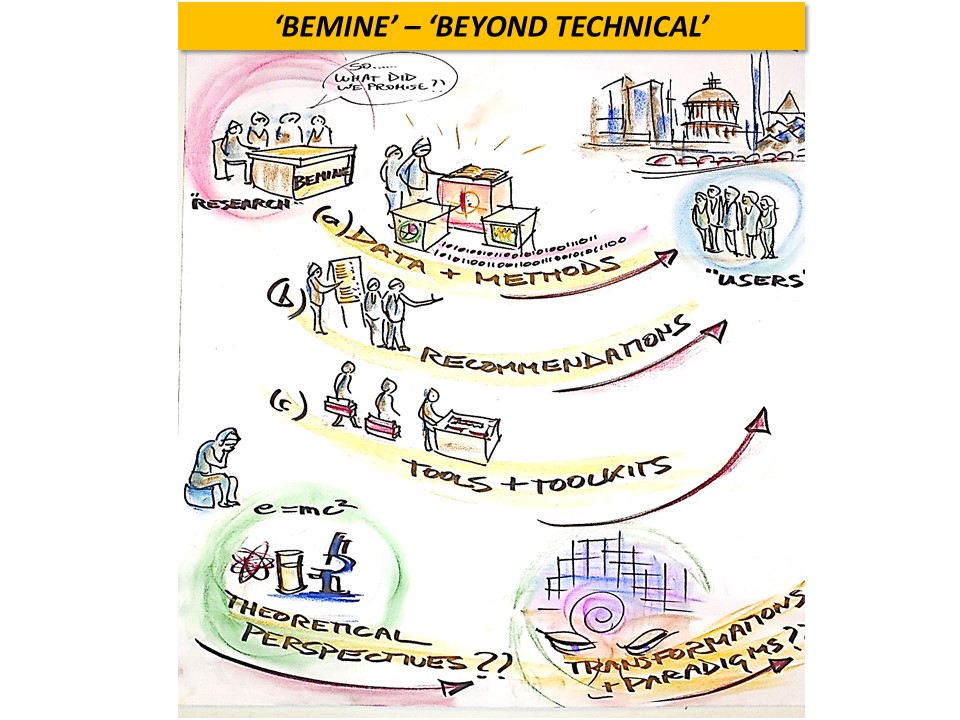Bemine (Finland)
 Finland is a beautiful and well-organized country. But its cities and infrastructures are expanding very fast. There are growing problems of urban sprawl, social segregation, displaced communities, and polarization of urban growth / rural decline. There are underlying problems of alienation and distrust which are not easy to understand. Finnish urban planning and urban governance is more efficient and well-informed than most, but it does not seem well suited to such problems.
Finland is a beautiful and well-organized country. But its cities and infrastructures are expanding very fast. There are growing problems of urban sprawl, social segregation, displaced communities, and polarization of urban growth / rural decline. There are underlying problems of alienation and distrust which are not easy to understand. Finnish urban planning and urban governance is more efficient and well-informed than most, but it does not seem well suited to such problems.

In response, the Bemine project looks beyond the technical / functional side of the urban planning system. It looks at deeper layers of the urban system, and wider possibilities for change and transformation. It uses collaborative ‘integrative envisioning’, to see how new forms of governance could work better, with complex problems and opportunities.
Bemine stands for ‘Beyond MALPE-coordination: INtegrative Envisioning’, where ‘MALPE’ is the Finnish system of spatial planning, with systematic coordination of land-use, housing, transport and economic development.
For the main Bemine project site, see the English version.
To use the Toolkit, go to the Overview.
What will the project deliver?

The cartoon version here shows three main strands of activity:
- Data & methods
- Recommendations to users
- Tools & toolkits
Overall this aims to bridge the gaps, between researchers with theoretical perspectives, and policy users who are trying to manage transformations.
What are the Key Concepts?
- We explore the institutions which shape urban governance, (formal structures of decisions and investments: and informal structures of discourses, coalitions, alignments), and the institutional needs for knowledge. This helps to understand the ‘actors’ involved.
- We explore the ‘imaginaries’e. mental constructions, particularly those for power, money and the future of the city.
- We explore the meaning of living, liveability, living together etc, which also helps to understand the motivations of actors.
- The question of knowledge needs comes back to the Bemine / Beyond Technical: should we focus on facts & figures and projections? Should we focus on experiences and fuzzy issues of power and discourse?Some of the key concepts emerged, as in the cartoon here…

What is the synergistic contribution?
The Bemine project is also an experimental zone for the Synergistic Toolkit. Here it is used to help the cross-fertilization of over 60+ research outputs, and the building of ‘Integrated Envisions’ for Finland.
The ‘Integrated Envision’ program aims to bring together a wide range of research, to explore new insights on urban transformations, and cross-cutting pathways forward. It is based on the Synergistic concepts, which are adapted for the purpose.
The program is enabled by the Integrated Envision Toolkit, an online platform. Each stage of the program is linked with the online ‘Envision’ pages. These contain materials for the research and development process: they are also a report on the results. Each page is linked to the 50-100 ‘Topics’, which are the ‘raw materials’ of direct research outputs.
All this is to explore the potential for collective intelligence, and the potential for co-creation & co-production, in theory and in practice. For example, urban policy should get everyone on board and mobilized, with co-creation of local knowledge and co-production of local services.
To use the Toolkit, go to the Overview.
How does the toolkit work?
The Integrated Envisioning Toolkit is an online platform, structured around the 4 stages of the Synergistic method.
- At the top level, the Overview page provides links to the whole of the Bemine research resource.
- At the middle level, the Envision pages are the result of research discussions and workshops. Each one is a compilation from the ‘raw’ research results.
- At the lower level, the ‘Topic’ pages are the individual research results, or ‘units of knowledge’. There are over 60 so far, each with the online template.

The Synergistic Web-tool pages here are a pilot version for demonstration and testing.
The Synergistic Web-Tool helps to manage and create knowledge on complex challenges. It provides simple online templates for the 4 stages of the synergistic process (i.e. baselines / scenarios / synergies/ strategies). The technology is there to support the human process, where we learn about problems, and design ways forward.
This demonstration for the Bemine project explores new integrated ‘Envisions’. The Envisions are cross-cutting, inter-connecting ‘nexuses’ or ‘narratives’. They aim at new insights which are beyond the results of any one study or field. The Envisions are the keys to exploring beyond current trends, to map newly emerging futures.
The Bemine ‘Integrated Envisions’ started with a knowledge mapping of 66 topics (i.e. ‘units of knowledge’), produced by the research partners.
- Each topic was put on a template, based on the synergistic method, i.e. ‘actors / factors / domains’.
- These were processed by network analysis, to produce a simple ‘knowledge mapping’ of the field.
The knowledge mapping is then used to explore the ‘Envisions’. These are cross-cutting, innovative combinations of knowledge, with new insights on complex, inter-connected, dynamic systems. The Envisions are developed through each of the 4 stages:
- ‘Baselines’ – the current situation. These are developed by co-design, based on the knowledge mapping of 66 topics (started in Feb 2018).
- ‘Scenarios’ – possible alternative futures (completed in 2017). These are compared to the Baselines.
- ‘Synergies’ – possible opportunities & innovations. These are about creative visions, new ideas and synergies (to be developed by co-design).
- ‘Pathways’ – roadmaps for strategic action. Each is a future-proofed pathway to turn the potential ideas into practical reality (to be developed by co-design).
Overall, this Web-tool is not a button to press for the ‘answer’ to complex problems – it’s a portal and support system for the human process of learning, thinking, creating and action.
To use the Web-tool go to the Overview
For advice on the Synergistic tools and techniques, see the toolkit
